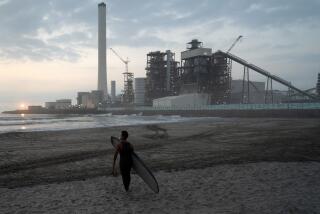So Far, Japan Rebuffs Atomic Agency’s Offer of Probe
VIENNA — Thorough inspection of Japan’s nuclear facilities by the International Atomic Energy Agency and review of the “extremely unusual” procedures that led to last week’s accident in Tokaimura could restore shaken public faith in that country’s nuclear program, the U.N. agency’s spokesman asserted Monday.
But the IAEA’s 4-day-old offer to send an accident-analysis team from its international headquarters here has so far been rebuffed by Tokyo authorities, despite their being fully informed about the agency’s safety concerns after a series of accidents in Japan this decade, IAEA spokesman David Kyd said.
“We think this is a classic case where the international community needs to learn from what happened. But that’s the Japanese’s call,” Kyd said in an interview. “Everyone worldwide needs to be reassured. We need to find out why it happened, what happened and how we can prevent it from happening again in the future.”
Human error has been blamed for the accident that caused an uncontrolled chain reaction for 17 hours and exposed three workers at the JCO Co. plant in Tokaimura to life-threatening doses of radiation. Thursday’s disaster, the worst ever in a country that depends on nuclear power for a third of its energy, compounded concerns about the Japanese nuclear industry’s safety record that were already rife after a fire and explosion at the same plant two years ago and an earlier liquid-sodium spill at the Monju reactor, about 200 miles west of Tokyo.
“They’ve had a number of incidents this decade that have not just troubled experts but have troubled the population,” Kyd said, noting that public confidence in the industry is essential in densely populated Japan and that only full cooperation with international experts can put public fears to rest.
Kyd expressed confidence that Japanese authorities eventually will publish a full report on their review of the circumstances that led to Thursday’s accident, but he emphasized the agency’s keen interest in playing a role in the process.
No IAEA assistance was sought or accepted after the previous incidents, he said, but he added that the potentially fatal injuries sustained by the three JCO workers and the release of radiation into the atmosphere made Thursday’s accident “a qualitatively different situation.”
One serious cause for concern at the Tokaimura plant is the unusual practice of hand-processing uranium, instead of using robotic methods preferred for safety and technological reasons elsewhere in the world, Kyd said.
“This seems to us rather strange, having so much human involvement. . . . The risks are clear, and that’s why you now have three workers in life-threatening condition,” he said.
Kyd declined “for the time being” to disclose what specific concerns the agency has expressed to Japanese authorities in face-to-face meetings with regulatory officials who were coincidentally in Vienna for an annual conference at the time of the accident. He said IAEA officials remained hopeful that their offer of assistance will be accepted by Tokyo once the initial shock of the accident wears off.
The IAEA has no authority to insist on involvement in safety reviews in its member states, no matter how serious an accident or how many warning signals there might be. Only when aggressive intentions are suspected does the agency have the power to “show up at the gates and demand entry,” Kyd explained.
But he made clear that the agency wants a look at the policies and practices observed at Japan’s 53 nuclear reactors after what he described as processing techniques that violated established safety norms.
The first question the IAEA has for Japanese regulators is why such potentially hazardous material was being used at a plant in a residential area and whether Tokaimura is a prudent location for the fast-neutron reactor there. Another question unanswerable without an investigation, he said, is why the JCO plant workers put so much uranium into the processing vat at once--nearly seven times the safety standard.
Kyd also said he had yet to be persuaded that the JCO uranium-processing methods were “unique” in Japan.
“All of this is extremely unusual,” he said.
The IAEA team on standby since Friday consists of only three people because the agency assumes that Japan has the technical and medical expertise to deal with the consequences of the accident, Kyd said. But both the size of the delegation and the scope of its mission are negotiable with Tokyo authorities if they agree to let in the IAEA team, he added.
“We aren’t supercops. We don’t run around the world doing spot checks,” Kyd said. “That would be very expensive indeed, and countries jealously safeguard their right to regulatory control.”
But many other countries have asked for IAEA assistance after accidents, including at highly sensitive sites such as a Russian military facility in the formerly closed Siberian city of Tomsk.
More to Read
Sign up for Essential California
The most important California stories and recommendations in your inbox every morning.
You may occasionally receive promotional content from the Los Angeles Times.











